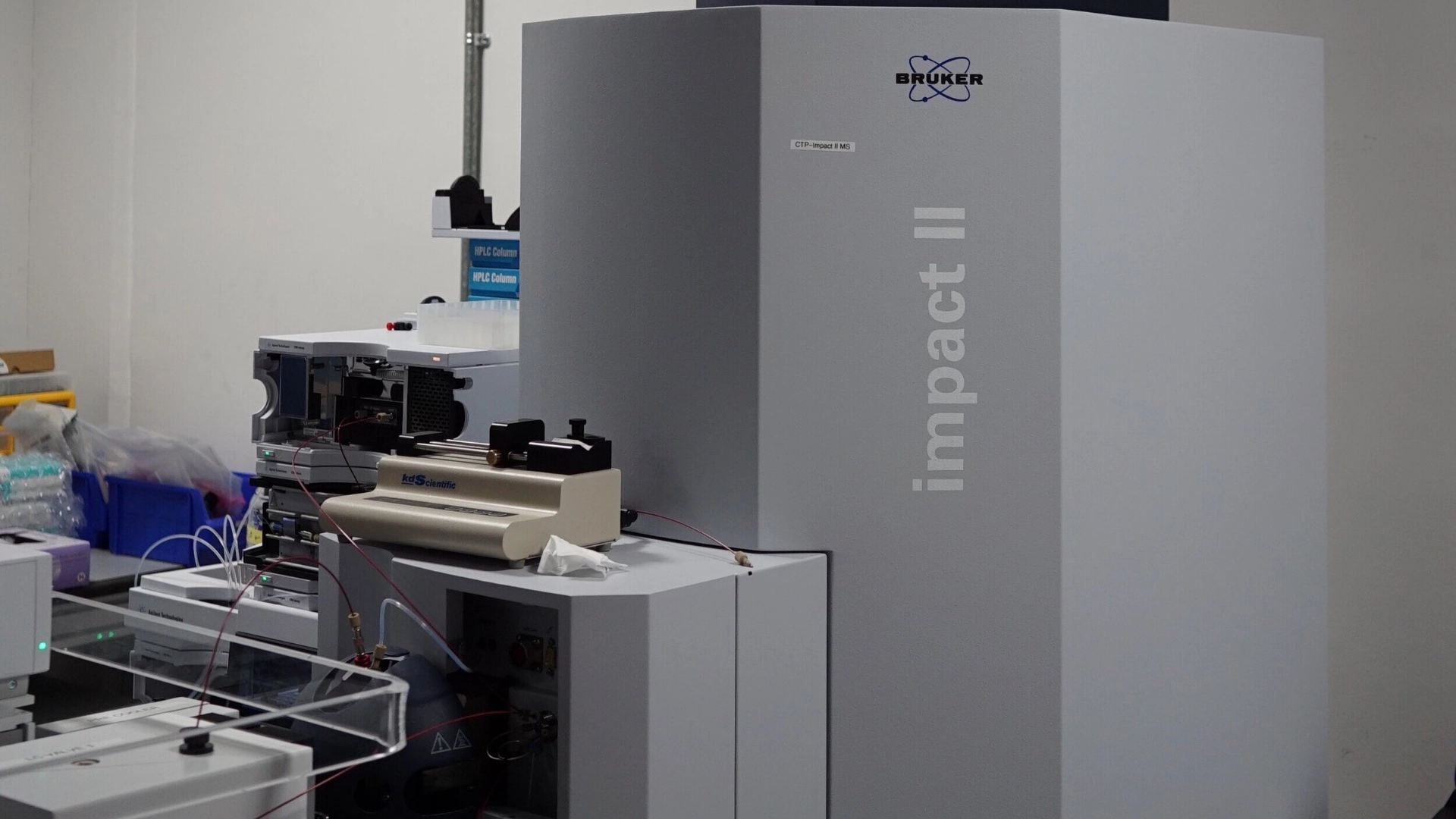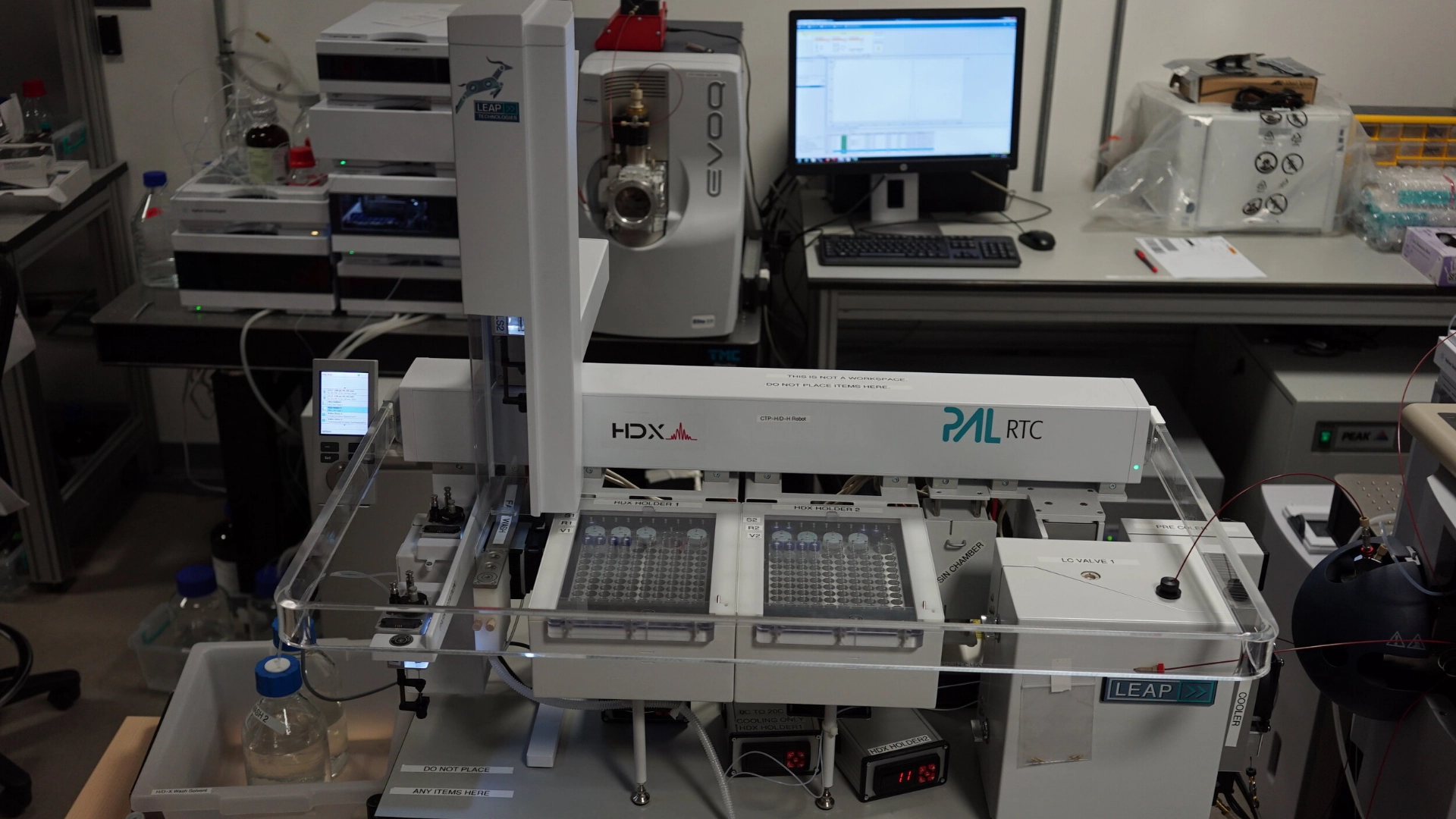Hydrogen Deuterium Exchange Mass Spectrometry
Exploring Protein Conformation and Dynamics through HDX-MS Techniques
Hydrogen Deuterium Exchange Mass Spectrometry (HDX-MS)


The Impact II mass spectrometer and the LEAP HDX Platform are two advanced instruments used in conjunction to collect HDX-MS data. HDX-MS is a powerful technique used to investigate protein folding, protein-ligand interactions, and conformational changes in biomolecules.
The Impact II is a high-performance mass spectrometer from Bruker that uses quadrupole time-of-flight (Q-TOF) technology. It is specifically designed for high-resolution, high-sensitivity applications such as proteomics, biomolecular research, and structural biology. It is capable of providing precise molecular mass determination and is commonly used in conjunction with various sample introduction techniques, including HDX-MS.
The LEAP HDX Platform is a dedicated system designed for HDX-MS experiments. The LEAP HDX Platform automates the critical step of sample preparation for HDX experiments, which involves the rapid exchange of labile hydrogen atoms in a protein with deuterium atoms from heavy water (D2O).
Key Features
Impact II
- High Sensitivity and Resolution: The Impact II is known for its high-resolution capabilities and sensitivity, which are critical for accurate and detailed proteomic and structural analysis.
- Q-TOF Technology: This enables high-accuracy mass measurements with low-background noise and high resolving power, crucial for complex samples.
- Fast Data Acquisition: The system provides rapid acquisition times, making it ideal for dynamic studies, such as those in HDX-MS, where time resolution is important.
- Broad Mass Range: It can analyze a wide range of molecular weights, making it versatile for various types of biomolecules including peptides, proteins, and larger complexes.
- Advanced Ion Mobility Spectrometry (IMS): Some versions may include ion mobility spectrometry, enhancing the ability to distinguish and characterize proteins with different shapes or conformations.
LEAP HDX Platform
- Automation of HDX Workflow: The LEAP HDX Platform automates the typically labor-intensive steps of HDX, including protein labeling, quenching the exchange reaction, and injecting the samples into the mass spectrometer.
- Temperature Control: It allows precise temperature control, which is important for managing the exchange reaction rates. Different temperatures can be applied to study the kinetics of HDX under various conditions.
- Multiple Exchange Time Points: The platform supports experiments with a wide range of exchange times, enabling time-course studies to probe dynamic conformational changes in proteins.
- Integrated with Mass Spectrometry: The LEAP HDX Platform is designed to seamlessly integrate with high-end mass spectrometers (like Bruker’s Impact II) to provide high-resolution data on the exchange kinetics.
Applications
The combination of the Impact II mass spectrometer and the LEAP HDX Platform is particularly powerful for several applications in structural and functional proteomics:
- Protein Conformational Studies: HDX-MS can be used to study protein folding and conformational changes by observing how hydrogen atoms in the protein backbone are exchanged with deuterium.
- Ligand Binding Studies: The technique is frequently applied to investigate how small molecules, such as drugs or inhibitors, bind to target proteins. Changes in the HDX rate can reflect binding events and conformational shifts in the protein upon ligand interaction.
- Protein-Protein Interactions: HDX-MS can help analyze the interaction interfaces between proteins or protein complexes, providing insights into the dynamics and structural rearrangements that occur upon binding.
- Epitope Mapping: This technique can be used for identifying epitopes recognized by antibodies by mapping which regions of the protein undergo changes in exchange rates upon antibody binding.
- Thermal Stability Studies: By conducting HDX-MS at varying temperatures, researchers can explore protein stability and the impact of temperature on protein dynamics.
- Biotherapeutic Development: The Impact II + LEAP HDX platform combination is used in the pharmaceutical industry to study therapeutic antibodies, biosimilars, and other biologics to understand their structural integrity, stability, and mechanisms of action.
